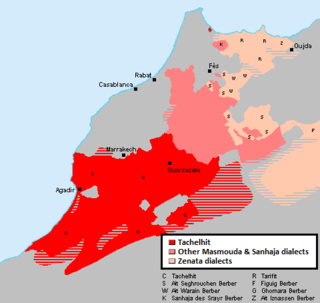
Back Idioma taixelhit AN أمازيغية شلحية Arabic تاشلحيت ARY لغه تشلحيت ARZ Tachelhit AST Ташлхит Bulgarian Chleuheg Breton Taixelhit Catalan Taschelhit German Ŝelha lingvo Esperanto
| Shilha | |
|---|---|
| Tachelhit; Tashelhiyt | |
| Taclḥiyt - ⵜⴰⵛⵍⵃⵉⵢⵜ - تاشلحيت | |
| Pronunciation | /ˈtæʃəlhɪt/ |
| Native to | Morocco |
| Region | Souss-Massa, Guelmim-Oued Noun, Drâa-Tafilalet, Marrakech-Safi, Béni Mellal-Khénifra, Laâyoune-Sakia El Hamra and Dakhla-Oued Ed-Dahab |
| Ethnicity | Shilha, Berber Jews |
Native speakers | 5.8 million (2020)[1] |
| Dialects | |
| Arabic, Latin, Tifinagh | |
| Language codes | |
| ISO 639-3 | shi |
| Glottolog | tach1250 |
 Tashelhit language area | |
| Person | Aclḥiy (male) Taclḥiyt (female) |
|---|---|
| People | Iclḥiyn (male) Ticlḥiyin (female) |
| Language | Taclḥiyt |
This section needs additional citations for verification. (June 2022) |
Shilha (/ˈʃɪlhə/ SHIL-hə; from its name in Moroccan Arabic, Šəlḥa), now more commonly known as Tashelhiyt, Tachelhit (/ˈtæʃəlhɪt/ TASH-əl-hit; from the endonym Taclḥiyt, IPA: [tæʃlħijt]),[a] is a Berber language spoken in southwestern Morocco. When referring to the language, anthropologists and historians prefer the name Shilha, which is in the Oxford English Dictionary (OED). Linguists writing in English prefer Tashelhit (or a variant spelling). In French sources the language is called tachelhit, chelha or chleuh.
Shilha is spoken in an area covering around 100,000 square kilometres. The area comprises the western part of the High Atlas mountains and the regions to the south up to the Draa River, including the Anti-Atlas and the alluvial basin of the Sous River. The largest urban centres in the area are the coastal city of Agadir (population over 400,000) and the towns of Guelmim, Taroudant, Oulad Teima, Tiznit and Ouarzazate.[citation needed]
In the north and to the south, Shilha borders Arabic-speaking areas. In the northeast, roughly along the line Demnate-Zagora, there is a dialect continuum with Central Atlas Tamazight. Within the Shilha-speaking area, there are several Arabic-speaking enclaves, notably the town of Taroudant and its surroundings. Substantial Shilha-speaking migrant communities are found in most of the larger towns and cities of northern Morocco and outside Morocco in Belgium, France, Germany, Canada, the United States and Israel.[citation needed]
Shilha possesses a distinct and substantial literary tradition that can be traced back several centuries before the protectorate era. Many texts, written in Arabic script and dating from the late 16th century to the present, are preserved in manuscripts. A modern printed literature in Shilha has developed since the 1970s.[citation needed]
- ^ Shilha at Ethnologue (26th ed., 2023)

Cite error: There are <ref group=lower-alpha> tags or {{efn}} templates on this page, but the references will not show without a {{reflist|group=lower-alpha}} template or {{notelist}} template (see the help page).